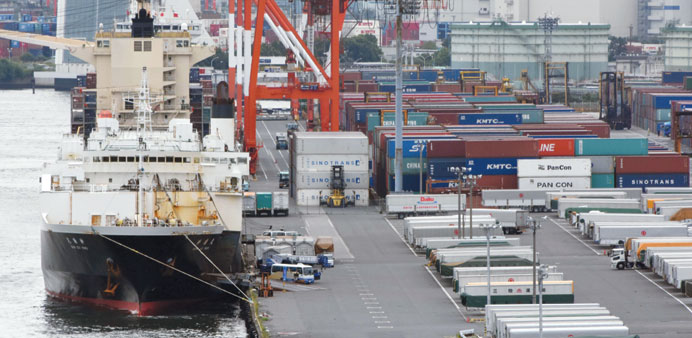Freighters are moored at a pier in Tokyo port. Japan’s monthly trade deficit fell to ¥268.05bn ($2.15bn), well below ¥966.5bn a year earlier, the finance ministry said.
AFP/Tokyo
Japan’s exports slowed in July, official data showed yesterday, adding to concerns about the fragile recovery in the world’s number three economy as demand falls in neighbouring giant China.
The lacklustre figures come days after news Japan’s economy contracted last quarter, boosting speculation the central bank will be forced to unleash more stimulus as Tokyo’s “Abenomics” growth blitz stumbles.
While the value of Japan’s exports rose 7.6% last month from a year ago, partly driven by rising vehicle shipments, the volume of goods slipped 0.7% from July 2014.
China-bound shipments were off 1.3% from 12 months earlier in volume terms, outstripping a 0.4% fall to the rest of Asia.
Despite a recovery in the US economy, a slowdown in China – Asia’s top economy and a major market for Japanese exporters – has raised a red flag.
The central bank devalued the yuan last week, sparking concern China is growing more slowly than thought and prompting fears it could start a currency war in which countries compete to boost exports by cutting the value of their units.
“The most notable point is that exports are not growing – the Japanese economy cannot rely on overseas demand for future growth,” said Taro Saito, a senior economist at NLI Research Institute.
“While the US and Europe are recovering compared with some other markets... China is dragging down
exports.”
The weak figures were part of broader picture that showed Japan’s trade deficit narrowed a less-than-expected 72.3% in July from a year ago, as the cost of energy imports kept falling.
Japan’s monthly deficit came in at ¥268.05bn ($2.15bn), well below ¥966.5bn a year earlier, the finance ministry said. Economists had predicted the shortfall would shrink to around ¥53bn. Imports fell 3.2% as weak commodity prices helped bring down the country’s energy bill, which soared after Tokyo replaced nuclear power with pricey fossil fuels in the aftermath of the 2011 Fukushima nuclear crisis.
Japan’s still-struggling trade picture was highlighted in the GDP data this week, as the economy shrank 0.4% in the three months to June – or 1.6% on an annualised basis.
The contraction, which was not quite as bad as expected, was blamed on weak consumer spending at home and slowing exports after two consecutive quarters of growth.
The figures come more than two years after Prime Minister Shinzo Abe launched a policy blitz, dubbed Abenomics, to kick-start anaemic growth and conquer years of deflation.
The scheme called for big government spending, massive Bank of Japan (BoJ) monetary easing and reforms to cut red tape in Japan’s highly regulated economy – reforms that have now stalled, however.
Household spending has also been unsteady following a sales tax rise last year, brought in to pay down a massive national debt, which saw consumers rush to stores before prices rose.
BoJ chief Haruhiko Kuroda has pushed back a timeline for hitting a 2% inflation target, a cornerstone of Abenomics, although he insists healthy price rises are around the corner.
This month, Kuroda said he would consider expanding the bank’s record ¥80tn annual asset-buying scheme – a means to pump money into the economy similar to the US Federal Reserve’s quantitative easing – if weak oil prices keep holding back near-zero inflation.



